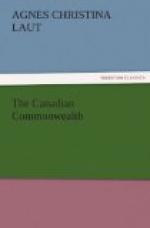The War of 1812 probably helped Canada’s national spirit more than it hurt it. It tested the French Canadian and found him loyal to the core; loyal, to be sure, not because he loved England more but rather because he loved the Americans less. He felt surer of religious freedom under English rule, which guaranteed it to him, than under the rule of the new republic, which he had harried and which had harried him in border raid for two centuries. The War of 1812 left Canada crippled financially but stronger in national spirit because she had tested her strength and repelled invasion.
If mountain pines strike strong roots into the eternal rocks because they are tempest-tossed by the wildest winds of heaven, then the next twenty years were destined to test the very fiber of Canada’s national spirit. All that was weak snapped and went down. The dry rot of political theory was flung to dust. Special interests, pampered privileges, the claims of the few to exploit the many, the claims of the many to rule wisely as the few—the shibboleth of theorists, the fine spun cobwebs of the doctrinaires, governmental ideals of brotherhood that were mostly sawdust and governmental practices that were mostly theft under privilege—all went down in the smash of the next twenty years’ tempest. All that was left was what was real; what would hold water and work out in fact.
It is curious how completely all records slur over the significance of the Rebellion of 1837. Canada is sensitive over the facts of the case to this day. Only a few years ago a book dealing with the unvarnished facts of the period was suppressed by a suit in court. As a rebellion, 1837 was an insignificant fracas. The rebels both in Ontario and Quebec were hopelessly outnumbered and defeated. William Lyon MacKenzie, the leader in Ontario, and Louis Papineau, the leader in Quebec, both had to flee for their lives. It is a question if a hundred people all told were killed. Probably a score in all were executed; as many again were sent to penal servitude; and several hundreds escaped punishment by fleeing across the boundary and joining in the famous night raids of Hunters’ Lodges. Within a few years both the leaders and exiles were permitted to return to Canada, where they lived honored lives. It was not as a rebellion that 1837 was epoch-making. It was in the clarifying of Canada’s national consciousness as to how she was to be governed.
Having migrated from the revolting colonies of New England and the South, the ultra-patriotic United Empire Loyalists unconsciously felt themselves more British than the French of Quebec. Canada was governed direct from Downing Street. There were local councils in both Toronto and Quebec—or Upper and Lower Canada, as they were called—and there were local legislatures; but the governing cliques were appointed by the Royal Governor, which meant that whatever little clique gained the Governor’s




